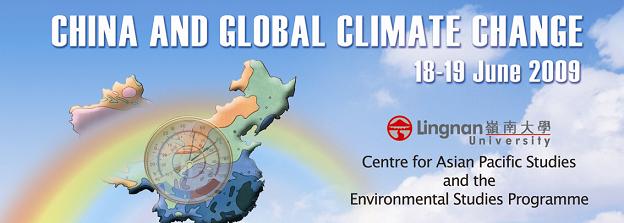
Event Title
Conference on China and Global Climate Change : Reconciling International Fairness and Protection of the Atmospheric Commons
Location
AM308, Lingnan University
Start Date
19-6-2009 11:00 AM
End Date
19-6-2009 12:30 PM
Language
English
Description
The vulnerability of China to the adverse impacts of rising global warming is outlined, including projected impacts on coastlines, agriculture, water supply, land degradation, and public health, since these are important reasons why China, partly for reasons of national security, is increasingly addressing the climate change problem in national and international discussions. This paper then profiles China’s greenhouse gas (GHG) emissions and illustrates how the pressure from the international community, especially that from the US, would impel China to make more substantial contribution to global climate effort. After examining China’s coal-dominated energy mix, we review the current approaches undertaken by China to combat climate change. They are essentially programs that aim to increase energy efficiency and deploy alternative energies, thus reducing energy costs and bringing about ancillary climate benefits. China’s active participation in the Clean Development Mechanism (CDM) is then discussed. We show that it appears to be impossible, with current or currently developing technologies such as Carbon Capture and Storage (CCS), to produce the 80% reductions in GHG emissions which scientists recommend over the next four decades. What other measures might be feasible for China to make more substantial contributions to global climate-change-mitigation efforts? China’s dilemma is the need to sustain a developing economy which depends crucially on GHG-emitting processes. It appears to be impossible to do this without some radical restructuring of economic activity, since it seems that it cannot be done by some combination of greater energy-efficiency and substituting fossil fuels by renewables or nuclear power. An alternative over the longer term is to promote relocalization of production and exchange using local and regional renewable resources. There are many towns and cities in the world in which groups are planning and beginning to implement such changes. In fact, China is almost uniquely well-qualified to take this approach, and indeed, could become a leader in such innovations and such technologies. In the longer term, it is very much in China’s national interest to follow this path.
Document Type
Presentation
Recommended Citation
Miao, B., & Lang, G. (2009). China’s dilemma in climate change mitigation: The energy problem. In China and global climate change: Proceedings of the conference held at Lingnan University, Hong Kong, 18-19 June 2009 (pp. 351-371). Centre for Asian Pacific Studies and the Environmental Studies Programme, Lingnan University, Hong Kong.
Included in
China’s dilemma in climate change mitigation : the energy problem
AM308, Lingnan University
The vulnerability of China to the adverse impacts of rising global warming is outlined, including projected impacts on coastlines, agriculture, water supply, land degradation, and public health, since these are important reasons why China, partly for reasons of national security, is increasingly addressing the climate change problem in national and international discussions. This paper then profiles China’s greenhouse gas (GHG) emissions and illustrates how the pressure from the international community, especially that from the US, would impel China to make more substantial contribution to global climate effort. After examining China’s coal-dominated energy mix, we review the current approaches undertaken by China to combat climate change. They are essentially programs that aim to increase energy efficiency and deploy alternative energies, thus reducing energy costs and bringing about ancillary climate benefits. China’s active participation in the Clean Development Mechanism (CDM) is then discussed. We show that it appears to be impossible, with current or currently developing technologies such as Carbon Capture and Storage (CCS), to produce the 80% reductions in GHG emissions which scientists recommend over the next four decades. What other measures might be feasible for China to make more substantial contributions to global climate-change-mitigation efforts? China’s dilemma is the need to sustain a developing economy which depends crucially on GHG-emitting processes. It appears to be impossible to do this without some radical restructuring of economic activity, since it seems that it cannot be done by some combination of greater energy-efficiency and substituting fossil fuels by renewables or nuclear power. An alternative over the longer term is to promote relocalization of production and exchange using local and regional renewable resources. There are many towns and cities in the world in which groups are planning and beginning to implement such changes. In fact, China is almost uniquely well-qualified to take this approach, and indeed, could become a leader in such innovations and such technologies. In the longer term, it is very much in China’s national interest to follow this path.


Additional Information
We would like to acknowledge research support from City University of Hong Kong. (Project # 961055: Environmental Best Practice: a Comparative Study)